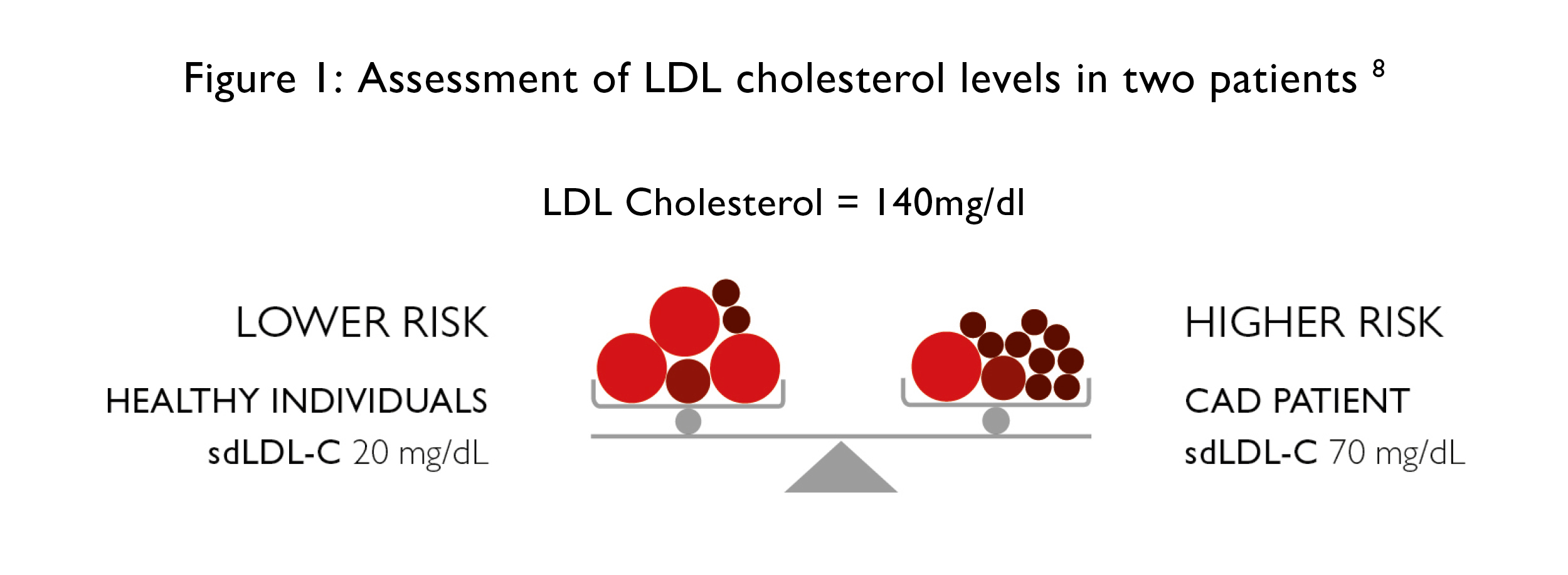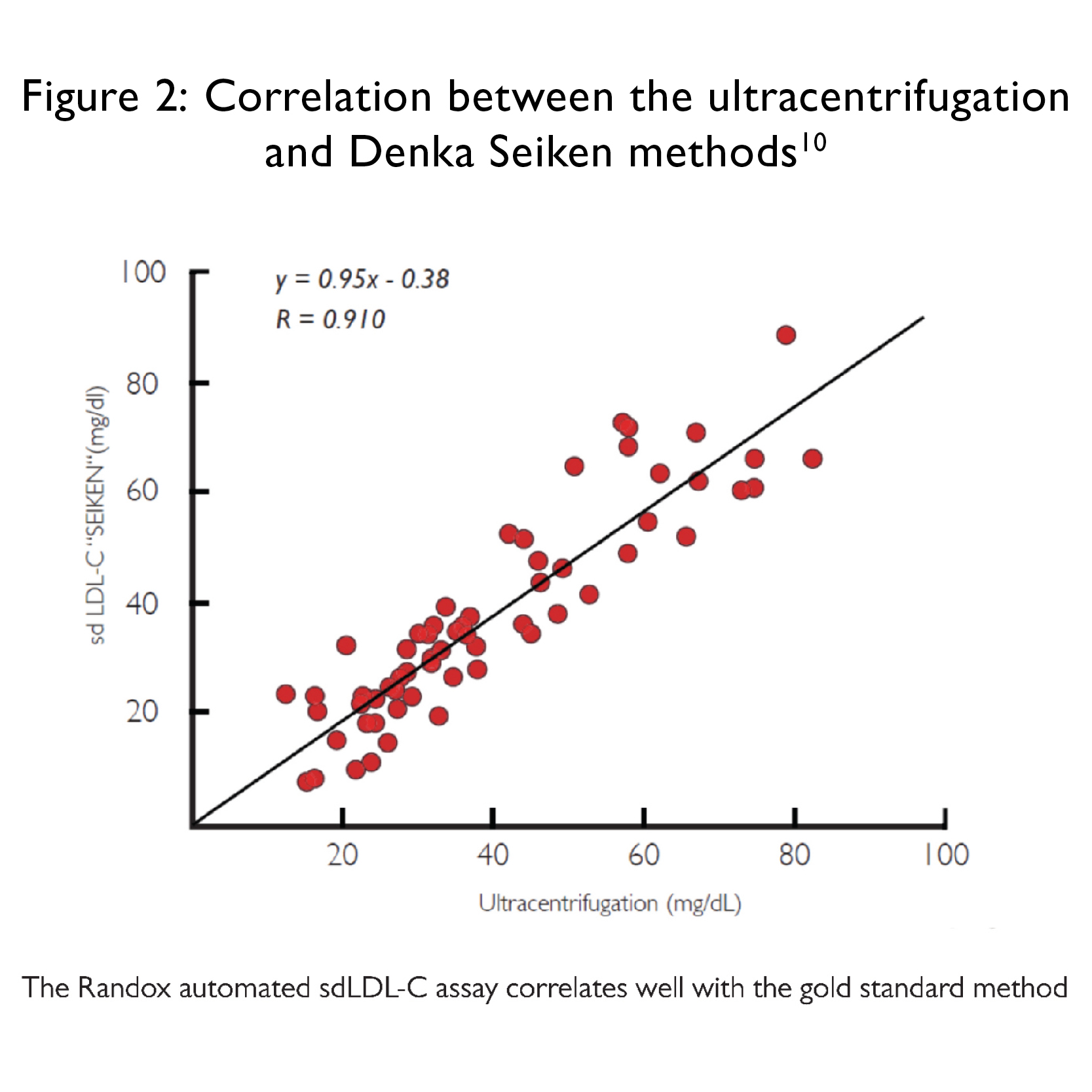Randox Unveils an Assay for the Rapid Measurement of Small Dense LDL Cholesterol (sdLDL-C)
|
By LabMedica International staff writers Posted on 13 May 2019 |

Assessment of LDL cholesterol levels in two patients (Photo courtesy of Randox).

Correlation between the ultracentrifugation and Denka Seiken methods (Photo courtesy of Randox).
A kit for the automated measurement of small dense low-density lipoprotein cholesterol (sdLDL-C) is now available with dedicated controls and calibrators available and instrument-specific applications for use with a wide range of biochemistry analyzers.
The lipid panel often used to assess cardiovascular disease risk comprises LDL cholesterol, HDL cholesterol, total cholesterol, and triglycerides. Results of these assays only detect about 20% of all atherosclerotic cardiovascular disease patients. However, studies have shown that sdLDL-C could predict risk of coronary heart disease in individuals considered being at low cardiovascular risk based on their LDL-C levels. These studies found that patients with a predominance of sdLDL-C had a three-fold increased risk of myocardial infarction (MI), while the relative risk was 4.5 for coronary artery disease and 7.0 for MI when sdLDL-C levels were greater than 100 milligrams per deciliter.
Until recently, the primary methods for determining a patient's sdLDL-C levels were based on laborious and time-consuming ultracentrifugation and electrophoresis. Then, in November 2017, the [U.S.] Food and Drug Administration granted 510(k) marketing clearance to Denka Seiken (Tokyo, Japan) for a small dense low-density lipoprotein cholesterol (sdLDL-C) assay designed for use on any standard clinical chemistry analyzer. The assay quantified sdLDL-C in serum and plasma samples in 10 minutes using a two-step process. The first step removed chylomicrons, very low LDL, intermediate-density lipoprotein, large LDL, and high-density lipoprotein using a surfactant and sphingomyelinase. In the second step, a specific surfactant released cholesterol only from the sdLDL-C particles for measurement by standard methods.
The Randox (Crumlin, United Kingdom) sdLDL-C assay utilizes the Denka Seiken method, providing accurate patient results. It was designed for use on automated biochemistry analyzers for efficiency and convenience. Applications are available detailing instrument-specific settings for the convenient use of the Randox sdLDL-C assay on a wide range of biochemistry analyzers. Dedicated sdLDL-C controls and calibrator are available providing a complete testing package. The Randox sdLDL-C assay is a niche product, and Randox is one of the only manufacturers of this test in an automated format.
The lipid panel often used to assess cardiovascular disease risk comprises LDL cholesterol, HDL cholesterol, total cholesterol, and triglycerides. Results of these assays only detect about 20% of all atherosclerotic cardiovascular disease patients. However, studies have shown that sdLDL-C could predict risk of coronary heart disease in individuals considered being at low cardiovascular risk based on their LDL-C levels. These studies found that patients with a predominance of sdLDL-C had a three-fold increased risk of myocardial infarction (MI), while the relative risk was 4.5 for coronary artery disease and 7.0 for MI when sdLDL-C levels were greater than 100 milligrams per deciliter.
Until recently, the primary methods for determining a patient's sdLDL-C levels were based on laborious and time-consuming ultracentrifugation and electrophoresis. Then, in November 2017, the [U.S.] Food and Drug Administration granted 510(k) marketing clearance to Denka Seiken (Tokyo, Japan) for a small dense low-density lipoprotein cholesterol (sdLDL-C) assay designed for use on any standard clinical chemistry analyzer. The assay quantified sdLDL-C in serum and plasma samples in 10 minutes using a two-step process. The first step removed chylomicrons, very low LDL, intermediate-density lipoprotein, large LDL, and high-density lipoprotein using a surfactant and sphingomyelinase. In the second step, a specific surfactant released cholesterol only from the sdLDL-C particles for measurement by standard methods.
The Randox (Crumlin, United Kingdom) sdLDL-C assay utilizes the Denka Seiken method, providing accurate patient results. It was designed for use on automated biochemistry analyzers for efficiency and convenience. Applications are available detailing instrument-specific settings for the convenient use of the Randox sdLDL-C assay on a wide range of biochemistry analyzers. Dedicated sdLDL-C controls and calibrator are available providing a complete testing package. The Randox sdLDL-C assay is a niche product, and Randox is one of the only manufacturers of this test in an automated format.
Latest Clinical Chem. News
- AI-Powered Blood Test Accurately Detects Ovarian Cancer
- Automated Decentralized cfDNA NGS Assay Identifies Alterations in Advanced Solid Tumors
- Mass Spectrometry Detects Bacteria Without Time-Consuming Isolation and Multiplication
- First Comprehensive Syphilis Test to Definitively Diagnose Active Infection In 10 Minutes
- Mass Spectrometry-Based Monitoring Technique to Predict and Identify Early Myeloma Relapse
- ‘Brilliantly Luminous’ Nanoscale Chemical Tool to Improve Disease Detection
- Low-Cost Portable Screening Test to Transform Kidney Disease Detection
- New Method Uses Pulsed Infrared Light to Find Cancer's 'Fingerprints' In Blood Plasma
- Carbon Nanotubes Help Build Highly Accurate Sensors for Continuous Health Monitoring
- Paper-Based Device Boosts HIV Test Accuracy from Dried Blood Samples
- AI-Powered Raman Spectroscopy Method Enables Rapid Drug Detection in Blood
- Novel LC-MS/MS Assay Detects Low Creatinine in Sweat and Saliva
- Biosensing Technology Breakthrough Paves Way for New Methods of Early Disease Detection
- New Saliva Test Rapidly Identifies Paracetamol Overdose
- POC Saliva Testing Device Predicts Heart Failure in 15 Minutes

- Screening Tool Detects Multiple Health Conditions from Single Blood Drop
Channels
Molecular Diagnostics
view channel
Groundbreaking Molecular Diagnostic Test Accurately Diagnoses Major Genetic Cause of COPD
Chronic obstructive pulmonary disease (COPD) and Alpha-1 Antitrypsin Deficiency (AATD) are both conditions that can cause breathing difficulties, but they differ in their origins and inheritance.... Read more
First-in-Class Diagnostic Blood Test Detects Axial Spondyloarthritis
Axial spondyloarthritis (axSpA) is a chronic inflammatory autoimmune condition that typically affects individuals during their most productive years, with symptoms often emerging before the age of 45.... Read more
New Molecular Label to Help Develop Simpler and Faster Tuberculosis Tests
Tuberculosis (TB), the deadliest infectious disease globally, is responsible for infecting an estimated 10 million people each year and causing over 1 million deaths annually. While chest X-rays and molecular... Read more
Biomarker Discovery Paves Way for Blood Tests to Detect and Treat Osteoarthritis
The number of individuals affected by osteoarthritis is projected to exceed 1 billion by 2050. The primary risk factor for this common, often painful chronic joint condition is aging, and, like aging itself,... Read moreHematology
view channel
First Point-of-Care Heparin Monitoring Test Provides Results in Under 15 Minutes
Heparin dosing requires careful management to avoid both bleeding and clotting complications. In high-risk situations like extracorporeal membrane oxygenation (ECMO), mortality rates can reach about 50%,... Read more
New Scoring System Predicts Risk of Developing Cancer from Common Blood Disorder
Clonal cytopenia of undetermined significance (CCUS) is a blood disorder commonly found in older adults, characterized by mutations in blood cells and a low blood count, but without any obvious cause or... Read moreImmunology
view channel
Stem Cell Test Predicts Treatment Outcome for Patients with Platinum-Resistant Ovarian Cancer
Epithelial ovarian cancer frequently responds to chemotherapy initially, but eventually, the tumor develops resistance to the therapy, leading to regrowth. This resistance is partially due to the activation... Read more
Machine Learning-Enabled Blood Test Predicts Immunotherapy Response in Lymphoma Patients
Chimeric antigen receptor (CAR) T-cell therapy has emerged as one of the most promising recent developments in the treatment of blood cancers. However, over half of non-Hodgkin lymphoma (NHL) patients... Read moreMicrobiology
view channel
Molecular Stool Test Shows Potential for Diagnosing TB in Adults with HIV
Tuberculosis (TB), caused by the bacterium Mycobacterium tuberculosis, led to 1.25 million deaths in 2023, with 13% of those occurring in people living with HIV. The current primary diagnostic method for... Read more
New Test Diagnoses Bacterial Meningitis Quickly and Accurately
Bacterial meningitis is a potentially fatal condition, with one in six patients dying and half of the survivors experiencing lasting symptoms. Therefore, rapid diagnosis and treatment are critical.... Read morePathology
view channel
Groundbreaking Chest Pain Triage Algorithm to Transform Cardiac Care
Cardiovascular disease is responsible for a third of all deaths worldwide, and chest pain is the second most common reason for emergency department (ED) visits. With EDs often being some of the busiest... Read more
AI-Based Liquid Biopsy Approach to Revolutionize Brain Cancer Detection
Detecting brain cancers remains extremely challenging, with many patients only receiving a diagnosis at later stages after symptoms like headaches, seizures, or cognitive issues appear. Late-stage diagnoses... Read moreTechnology
view channel
Advanced Predictive Algorithms Identify Patients Having Undiagnosed Cancer
Two newly developed advanced predictive algorithms leverage a person’s health conditions and basic blood test results to accurately predict the likelihood of having an undiagnosed cancer, including ch... Read more
Light Signature Algorithm to Enable Faster and More Precise Medical Diagnoses
Every material or molecule interacts with light in a unique way, creating a distinct pattern, much like a fingerprint. Optical spectroscopy, which involves shining a laser on a material and observing how... Read more
Disposable Microchip Technology Could Selectively Detect HIV in Whole Blood Samples
As of the end of 2023, approximately 40 million people globally were living with HIV, and around 630,000 individuals died from AIDS-related illnesses that same year. Despite a substantial decline in deaths... Read more
Pain-On-A-Chip Microfluidic Device Determines Types of Chronic Pain from Blood Samples
Chronic pain is a widespread condition that remains difficult to manage, and existing clinical methods for its treatment rely largely on self-reporting, which can be subjective and especially problematic... Read moreIndustry
view channel
Cepheid and Oxford Nanopore Technologies Partner on Advancing Automated Sequencing-Based Solutions
Cepheid (Sunnyvale, CA, USA), a leading molecular diagnostics company, and Oxford Nanopore Technologies (Oxford, UK), the company behind a new generation of sequencing-based molecular analysis technologies,... Read more
Grifols and Tecan’s IBL Collaborate on Advanced Biomarker Panels
Grifols (Barcelona, Spain), one of the world’s leading producers of plasma-derived medicines and innovative diagnostic solutions, is expanding its offer in clinical diagnostics through a strategic partnership... Read more









 RapiCardTM InstaTest (Serum-WB-Plasma).jpg)









